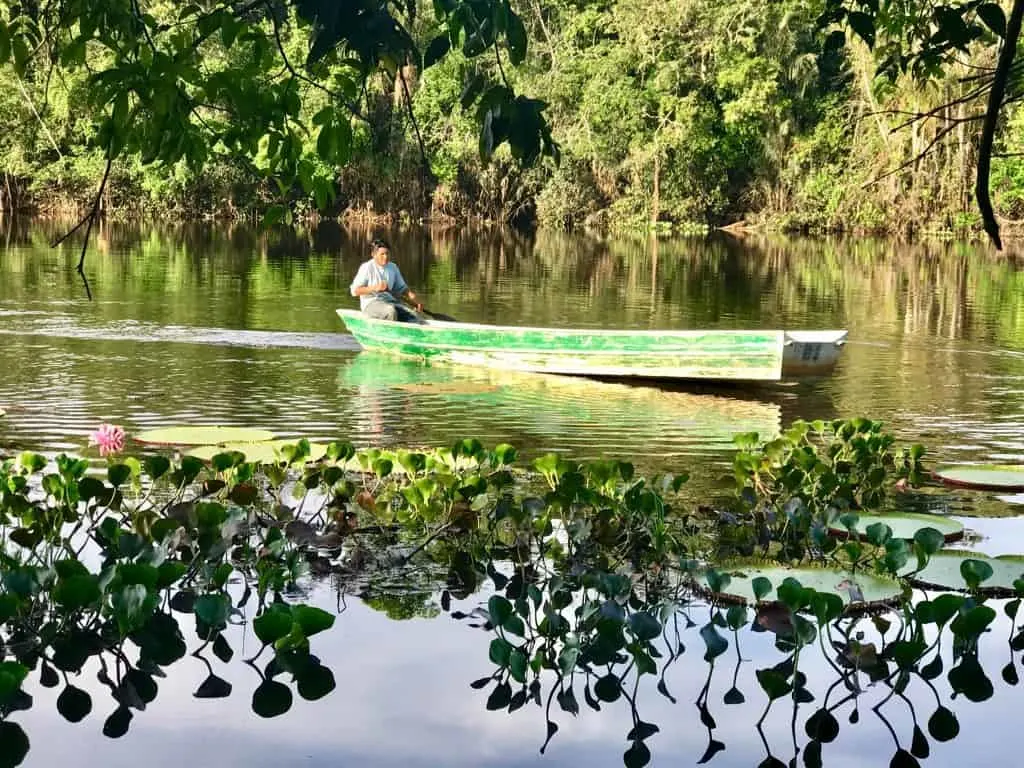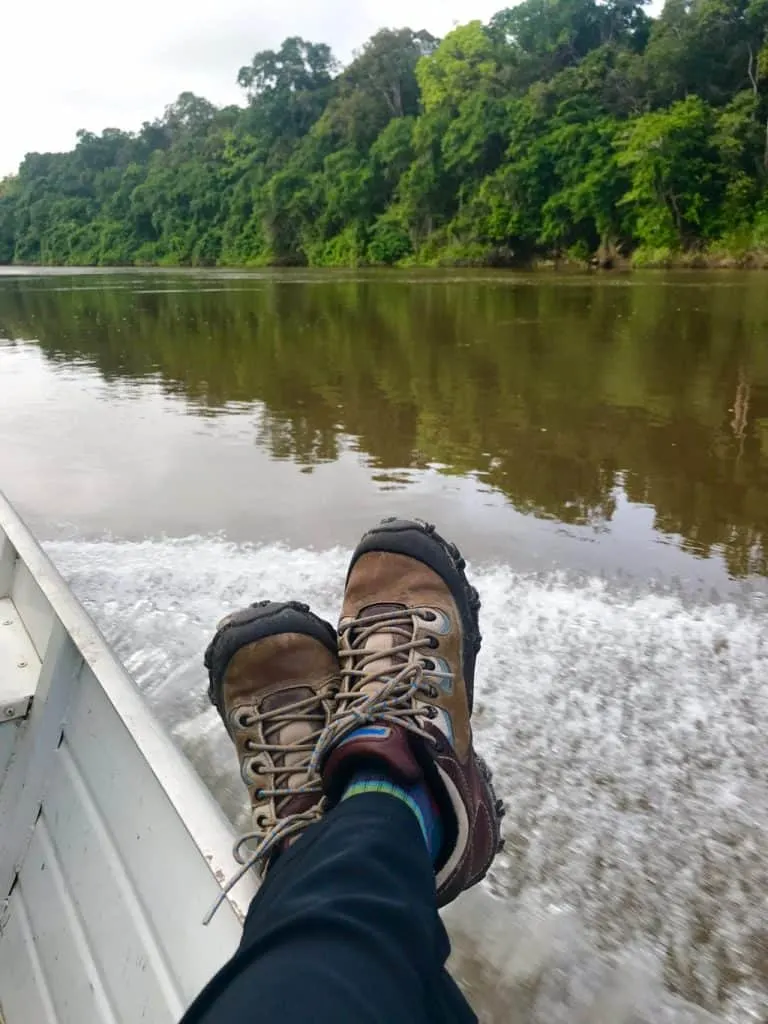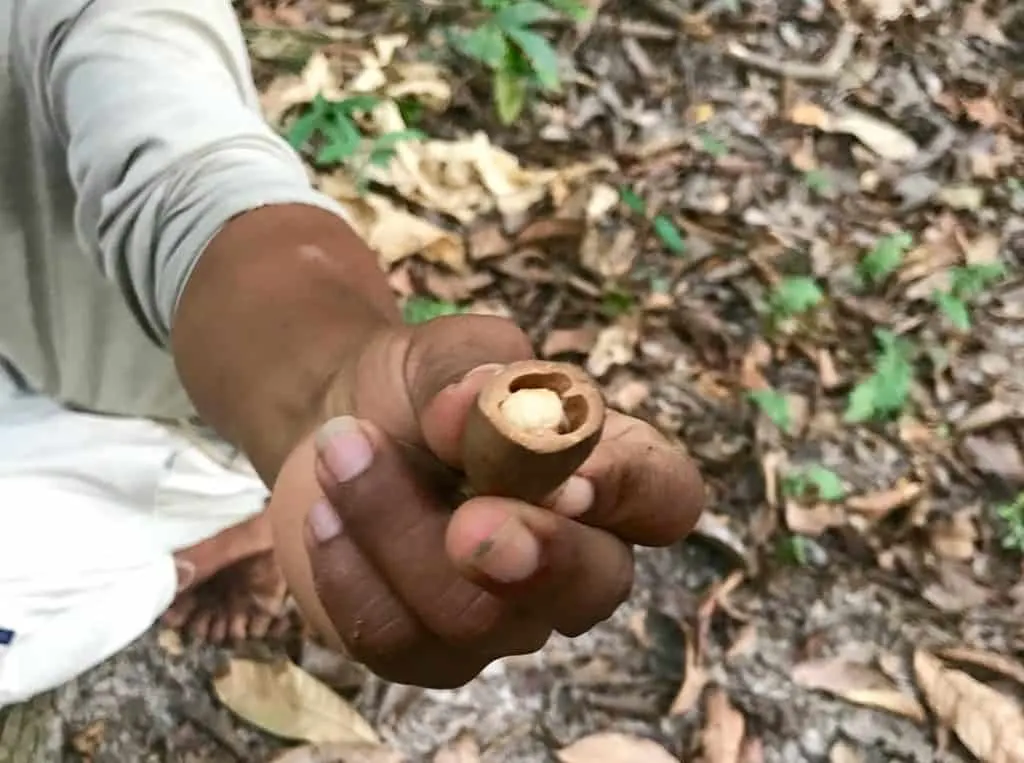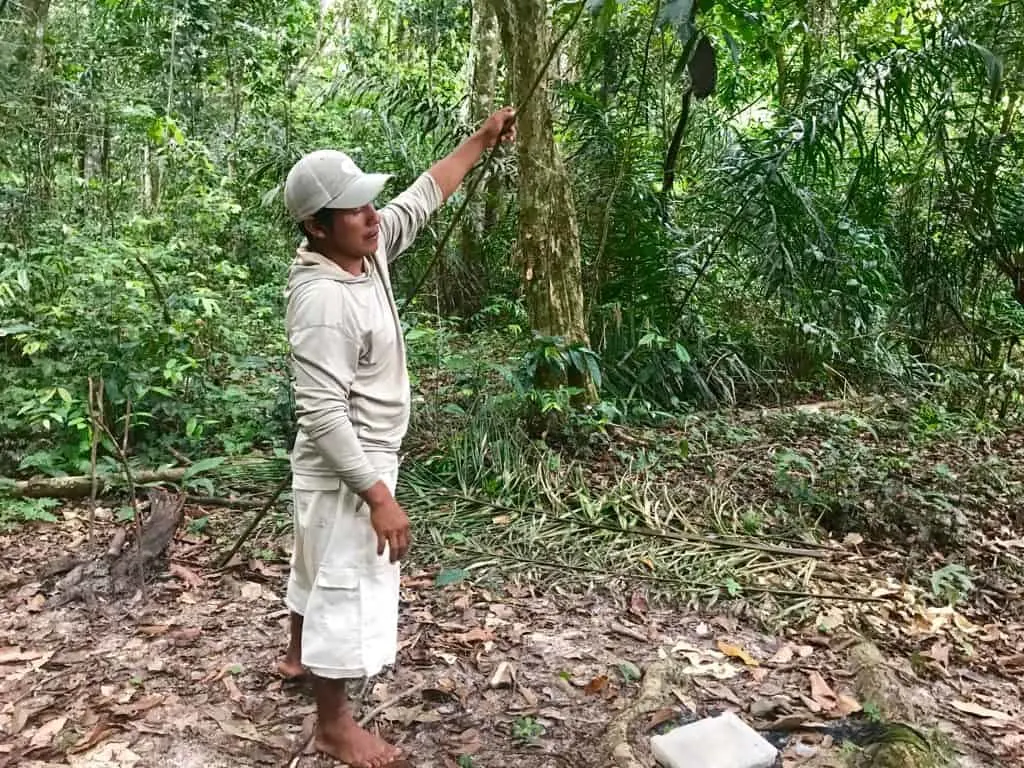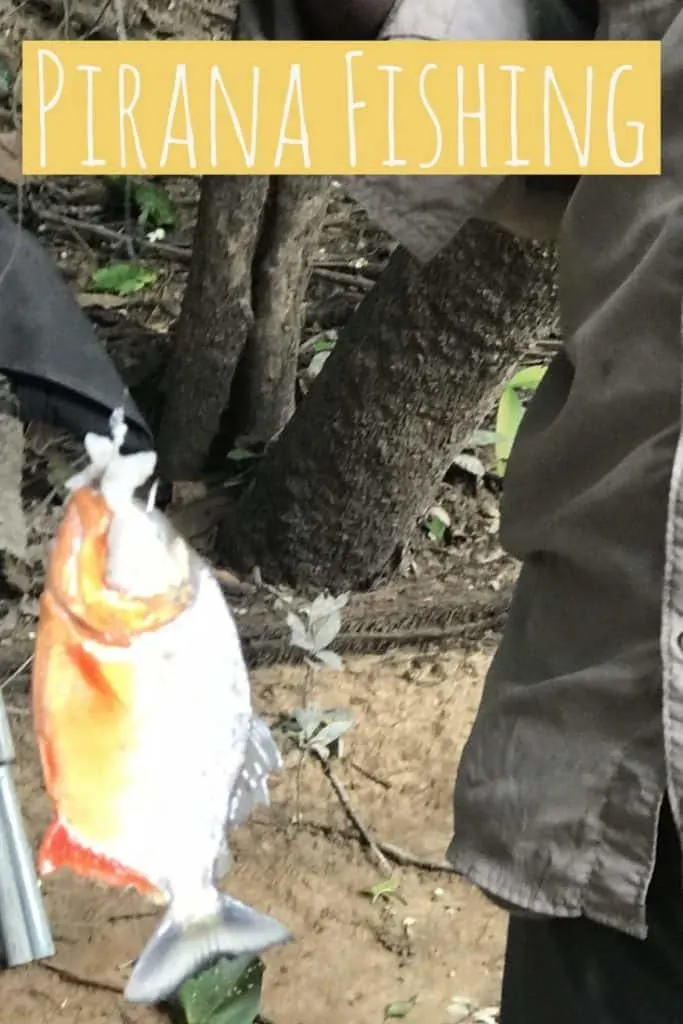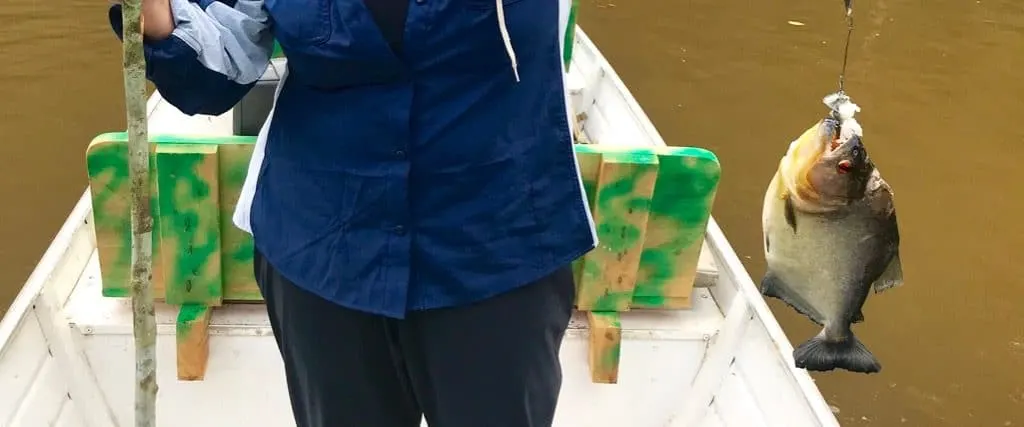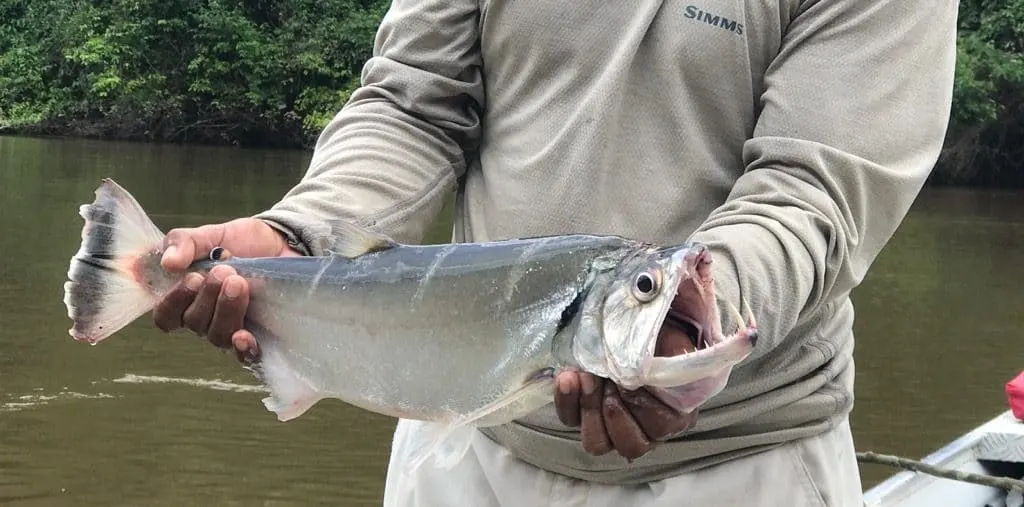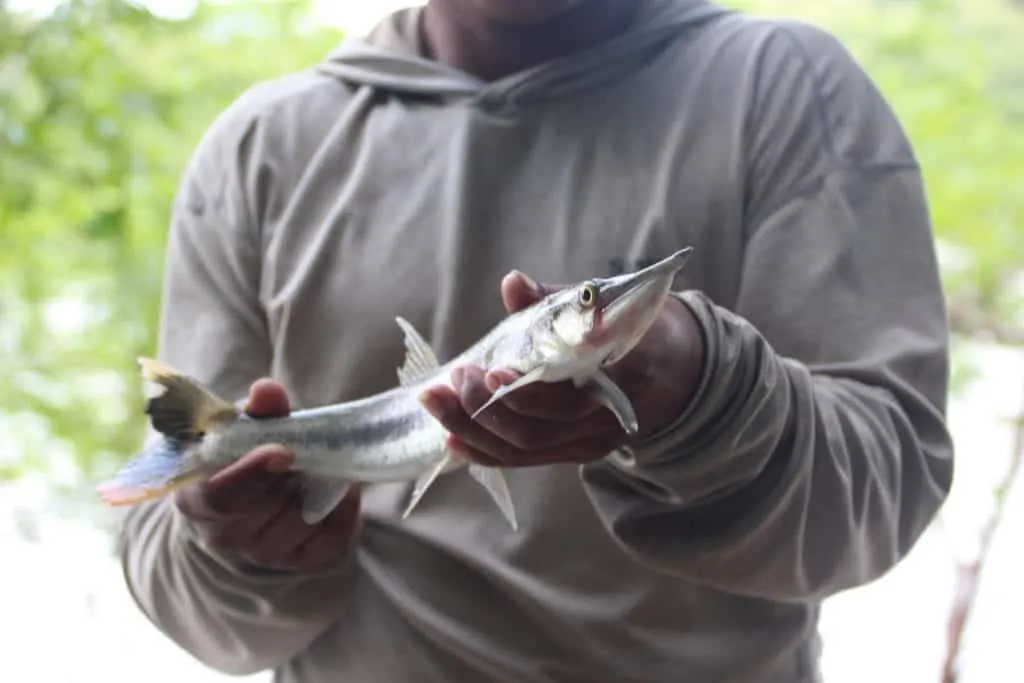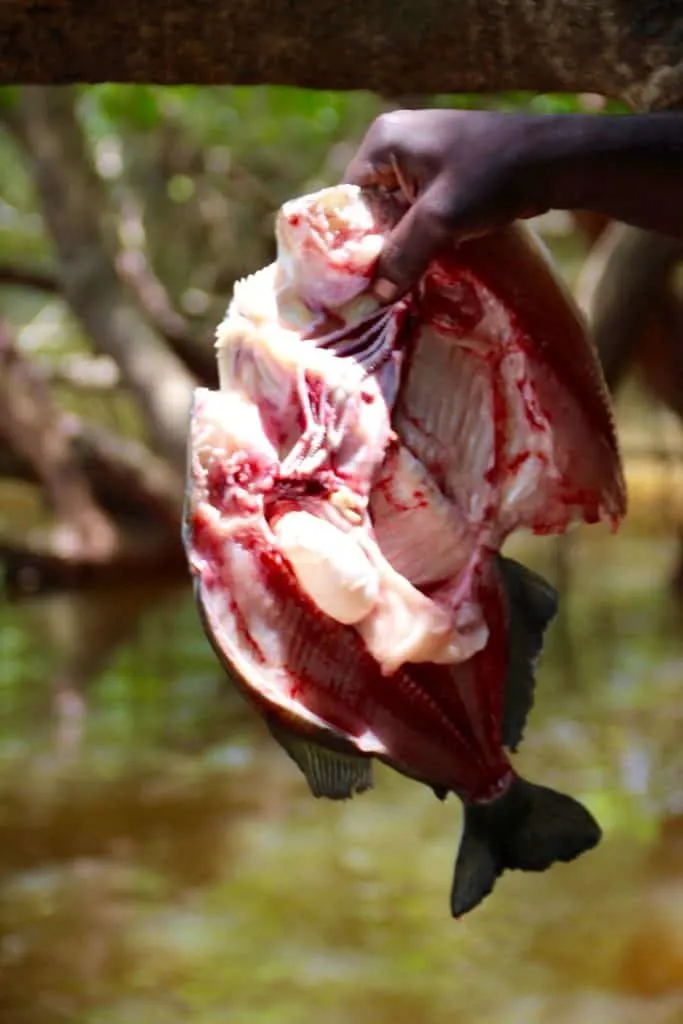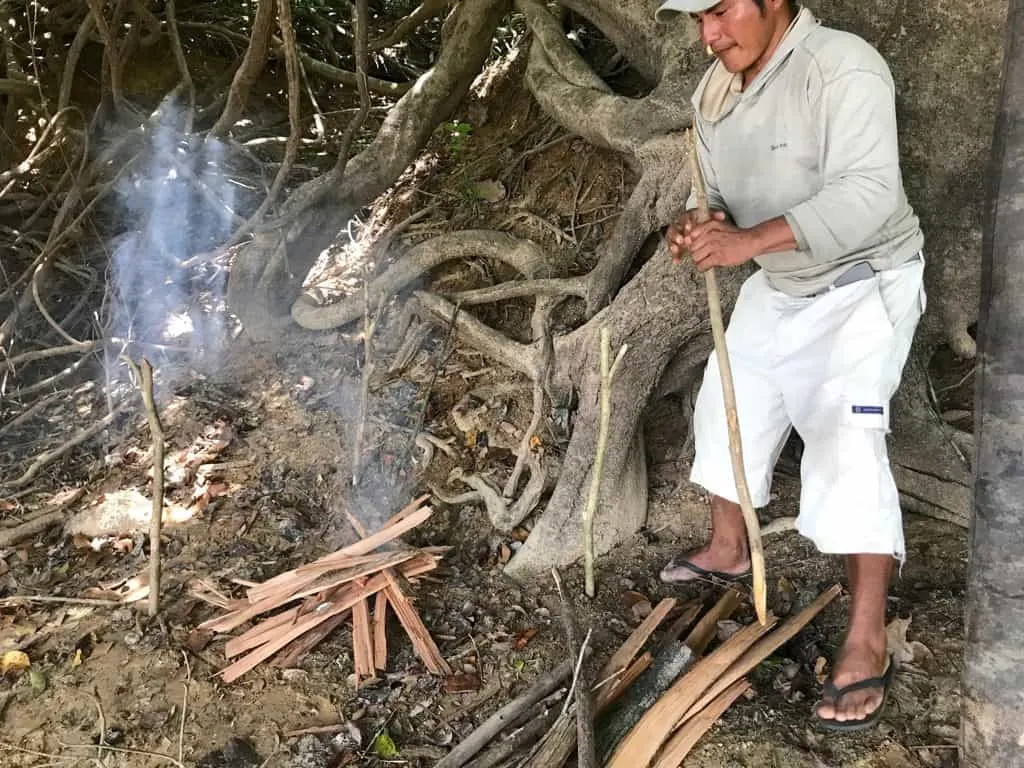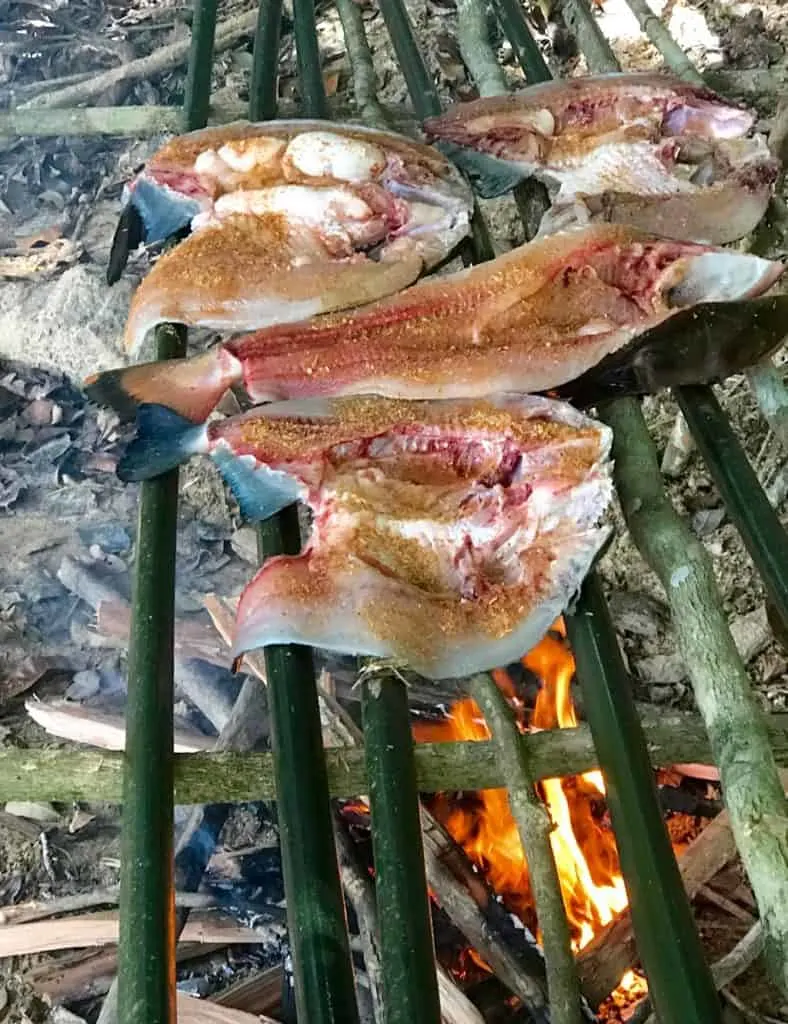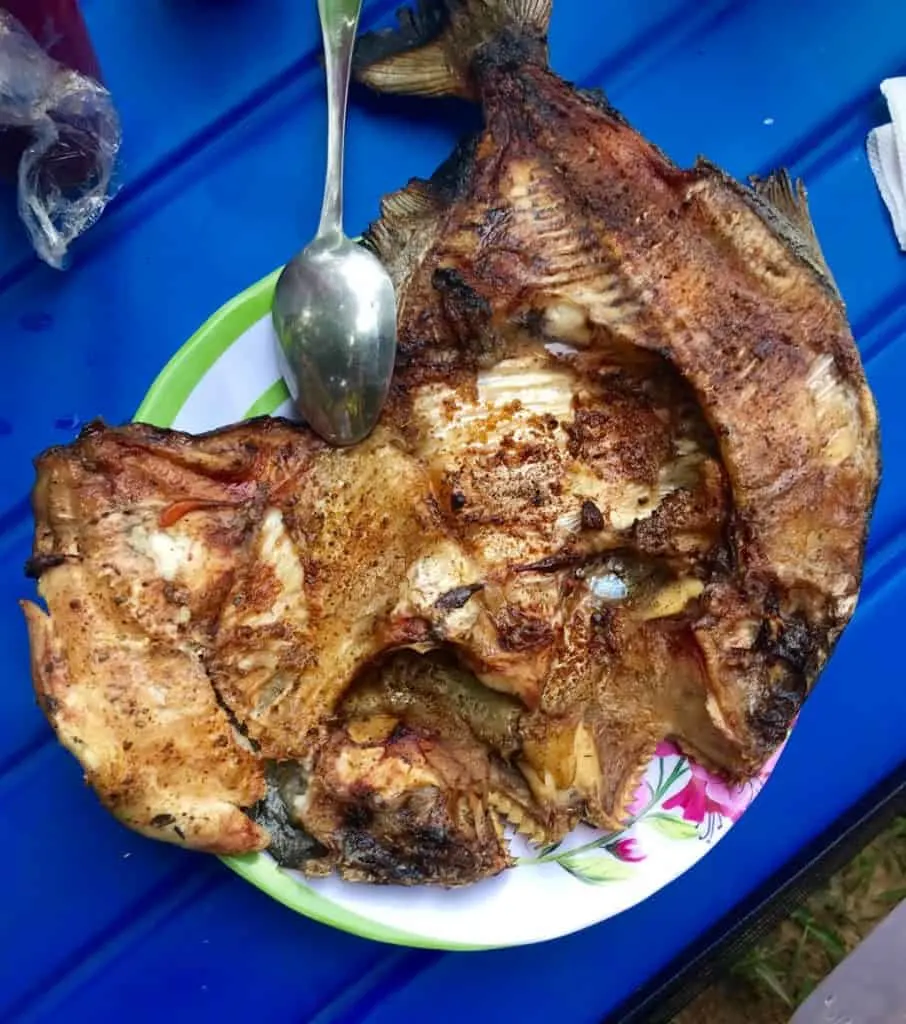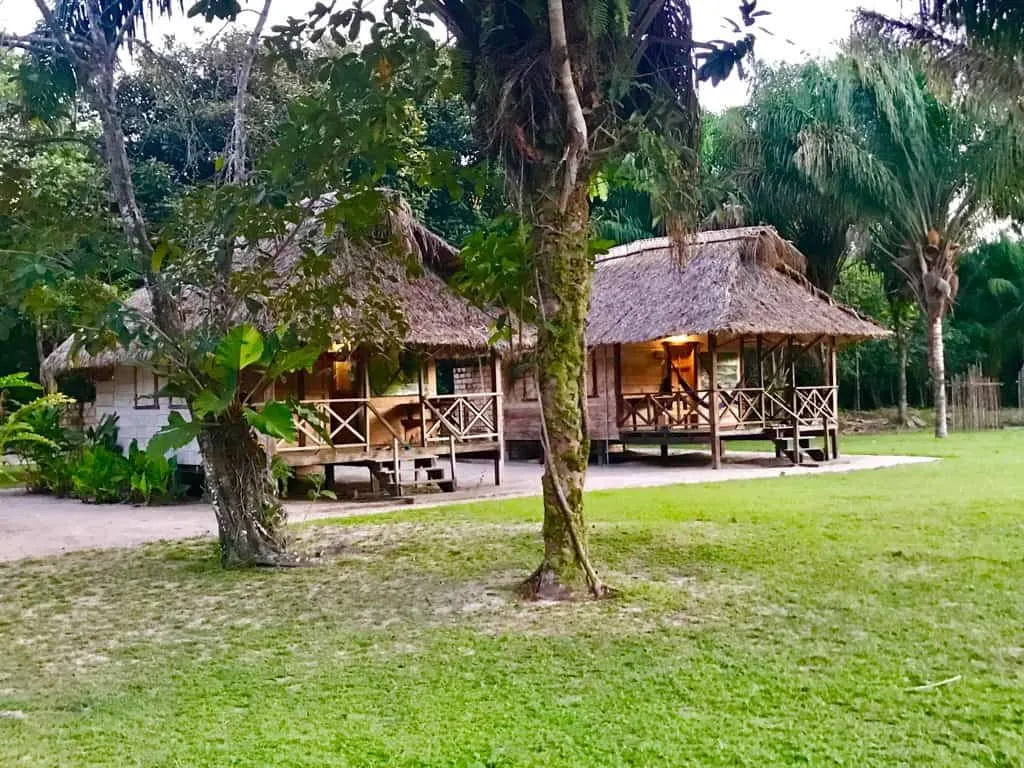Well, there is a first time for everything. And on the agenda for this day that I was in Guayana was this: Pirana Fishing, it was staring me in the face, as I fumbled through the itinerary. I have been out of my comfort zone before, so here we go…Pirana fish are known to quickly devour any small morsel that falls into its muddy water lair. Pirana has also been known to bite objects many times their own size, including livestock and even humans. Although adult humans are not on the menu for even the red-bellied pirana, you should always be careful when in their territory.
Pirana Fishing!
So here we go, let’s dive into the topic (and not the water) as we explore the ins and outs of Pirana Fishing in Guyana. With the help of my local guides, I will show you how to make your Pirana fishing experience a memorable, if not a crazy one! See all the things I am up for on a trip! And as they say “When in Rome, do as the Romans do. When visiting a foreign land (Guyana), follow the customs of those who live in it. So come along with me and see how it turns out!
Pirana Fishing 101
Some extraordinary things in this world start from humble beginnings. In the wild, this is especially true with entire forests growing from a single tree. Ruthless ant colonies develop from a vulnerable defenseless queen. Even the mighty pirana fish whose journey begins the size of a human thumbnail. Pirana, the most notorious of bony fish, is indigenous to the Amazon basin among other parts of South America.
Pirana fish begin their lives as small and non-threatening. They then grow to between 5 and 14 inches (12-35 cm) depending on the exact species. The red-bellied pirana was the fish that I saw and caught and they are the largest pirana fish and can grow up to 20 inches (50 cm) long! Going pirana fishing can be quite challenging depending on the season, as there are some months when the piranas are not as desperate to eat your bait! But that was not the case in the middle of September!
✦ Bait & Tackle for Pirana Fishing
Our Amerindian guides take the minimalistic approach to pirana fishing to a whole other level. Here you will see to what depths these people go to preserve the pristine nature of their jungle home. Your local guide will locate “grub” or tiny worm inside of a kokerit nut or seed, that drops from a palm tree and is found throughout the jungle in Guyana. They then use this wormlike insect to catch the bait for the bigger fish until they have a fish big enough to cut up and “feed to the bloodthirsty” pirana fish. This is quite a process as they go from grub to tiny fish, to the next sized fish, until they get one big enough to cut up and feed to the pirana, ie it takes a lot of time.
Have you heard of Globo Surf? Your #1 Source for Snow, Land, and Water Sports Reviews!
All in one place!
✦ Techniques for Pirana Fishing
My guide even went out into the jungle and came back with long tree branches or sticks, whittled them a bit, and then attached the fishing line and a hook. In other words, he made our fishing poles as well, for all 6 of us on the boat! And then we were off down the Rewa River to fish for pirana. The guide shows you how to go pirana fishing by putting the end of the “fishing pole” into the water and splashing it about in a circle vigorously. This, he says, “causes the fish to think something big is in the water.”
This is completely different than regular fishing where you have to be real quiet, as the fish at times seem smarter than the humans and realize there is a hook attached to that bait. Here, they go for the vigorously moving bait.
✦ Actual Pirana Fishing
We put our lines in the water and waited. We did not have long to wait. All of us got bites almost immediately. Our guide then told us we need to yank the line fast and pull up with one quick jerk. I lost my bait a lot, as these piranas are fast. But, it didn’t take long for the pirana or other fish to nibble. This happened quite a few times and I found what I believe to be the trick: the fresher the bait the more nibbles I would get. I didn’t have too much luck, but the girls at the front end of the boat certainly did and I noticed that they were constantly sticking their hooks in the guides’ face for a re-bait, so maybe that does have something to do with it. Otherwise, I am not much of a fisherwoman!
Once the pirana is on the fishing hook, it is best to pass it off to your fishing guide as he has the knowledge and experience to navigate the fish’s teeth with ease. The animal whose name literally translates to “toothfish” in the indigenous Tupí language should only be handled by experienced anglers (according to me). So, if you are like me, I let the guide get that dang snaggle-toothed fish off of my line. LOL
✦ Cooking and Eating the Pirana Fish & Other Fish We Caught
Our pirana fishing trip was successful; everyone caught at least one fish and overall we must have caught 20-30 fish total of all different varieties! Afterward, we headed downstream to an open area along the river’s bank to set up shop for lunch! Going back to the resourcefulness of the fishing guides, a makeshift “barbecue” was assembled almost out of thin air. It was made of tree branches that supported the fish over the open flame. Our group’s guides made it very clear that they had perfected this Amazonian dish as they grilled our lunch perfectly with an all-spice seasoning.
Now to the real question – what does pirana taste like? It had a mild taste similar to other white fish, like tilapia. It does not invoke any feelings of gamines nor did it have a tainted flavor of any kind. However, beware as pirana are notorious for a lot of tiny bones spread through their bodies. So chew carefully.
✦ When to Go Pirana Fishing
The rainy season in the Guyanese Amazon is usually from April through September. Fishing can sometimes prove to be more difficult despite the huge influx of water to Guyana’s rivers. This is because the rising water levels of the rainy season allow for the pirana to hide away in places not usually accessible to them. The splashing needed to attract the pirana to the boat will be less effective as they have more room to find food in places free of hooks and lines.
At the same time, going in the dry season can be troublesome. One positive is that there is less room for the pirana to maneuver amongst the fishermen’s lines. However, you will be unable to access some of Guyana’s hidden lakes and reservoirs due to the drop in water levels. If pirana fishing is a must for you on your trip to Guyana, I recommend arriving sometime after that. A few months after the rains have stopped is your best bet. By then the water carried by the rains has deposited elsewhere making it more likely for the pirana to bite.
✦ What to Bring when Pirana Fishing
When going pirana fishing in a place as warm and as humid as the Amazon, it is important to bring the bare essentials. A proper sun hat with a brim that covers your neck is an absolute must. With the beating sun coming down so close to the equatorial line, protection from UV rays will be crucial. This is because you will have no cover on the river during the hottest part of the day. Second, waterproof sunscreen is essential as the piranha (and other fish) you and your group catch will struggle and splash water. Without waterproof qualities, your sunscreen is as good as worthless when fishing for piranha on one of Guyana’s many rivers.
The third essential to bring is your bug spray. Mosquitos make their home in the stagnant water all over the jungle and so bringing a bug spray with a high content of DEET will improve your mood significantly as you float down the river. Finally, long airy clothes will not only protect you from the bugs and the sun but it will keep your body temperature down and give you a sense of relief (if only for a moment) during the hot and humid afternoon of pirana fishing.
Sunglasses: As we were just north of the equator on our pirana fishing trip, bringing sunglasses with you will come in handy against harmful UV rays, as well as, keeping hooks that go flying from wild fishing lines or hooking into your eye.
Headband/hair tie: Due to the humidity in the air, I highly recommend bringing a headband or some hair ties with you. The moisture hanging in the air may give you a bad hair day but do not let it stop you from having a great experience with just a couple of hair accessories. For me, they were a necessity to keep the sweaty hair off my neck.
✦ Other Useful Things to Bring when Pirana Fishing
This next part is a list of things that, while not necessary, should be useful to you while out on the river:
Hydrocortisone cream: Despite your best efforts to deter mosquitos and other jungle critters from biting you, some bites are inevitable. Bringing hydrocortisone cream with you will alleviate any itchy feeling and stop you from scratching the bite into oblivion.
Cleansing wipes and hand sanitizer: Having a packet of baby wipes or a small bottle of hand sanitizer can prove to be useful when deep in the Amazon, especially after Piranha fishing.
Extra memory card: Unless you are a maniac with checking the free space on your memory cards you should bring an extra one. It’s small so it will not be a nuisance if you end up not using it while on the river. I know I have been guilty of forgetting how much space was available on my memory card once or twice so my advice to you is always be prepared.
Plastic zip lock bags: These will be great for all the little things you bring on the boat. Your hydrocortisone cream, cleansing wipes, extra memory card, or even your camera itself can be stored here just in case something drops in the water.
Fishing line: Piranha fishing is an art to the locals of the Guyanese Amazon. It is a part of their culture to use the natural resources around them to complete their jungle tasks. One synthesized item that local fishermen use is fishing line so bring some extra thick line as a gift and it will go a long way with your guide.
✦ Where to Stay when Pirana Fishing
When my group and I fished for pirana, we stayed at the Rewa Eco-Lodge a nature lover’s jungle dream. It is located in central Guyana about 20 miles (32 km) east of the Apoterii landing strip, the closest village with an airstrip. The Rewa Eco-Lodge is run by the local Amerindian community of Rewa so proceeds to the lodge help to support the village economy.
The Amerindians have a long and rich history with the environment they inhabit. They keep the surrounding jungle as clean as possible for future generations of Amerindians and guests alike. The actual pirana fishing experience was organized by my tour guide and wildlife specialist, Leon Moore of Journey Guyana. So he can help you plan a trip to the South American Rainforest.
✦ Is Piranha Fishing Child-Friendly? No!
Some people have asked me if they can take their kids…toddlers should not be allowed on this excursion in case they fall into the water. As pirana fishing requires vigorous splashing. A small child falling into the river will definitely attract some unwanted attention. However, any mid-aged kid experienced in fishing, or one that is simply old enough to be a strong swimmer, will be safe, so age 10-12.
Despite the perceived bloodthirsty nature of the pirana fish, these animals are not as dangerous as the media claims them to be. So if you are wanting to go pirana fishing, then the jungles of Guyana are waiting for you!
Loved this article? Recommended Reading:
My Trip to Guyana in the South American Rainforest
Hungry? Guyanese Food: Learning A Culture Through Food
Kaieteur Falls: Majesty Brought to Life in Guyana
Disclosure: As is common in the travel industry, I was provided with accommodations, meals, and other compensation for the purposes of review by Guyana Tourism and its PR agency. While it has not influenced my review, PointsandTravel.com believes in full disclosure of all potential conflicts of interest. All Photos were taken by the author/or were given permission from the photographer. Affiliate links may be located in this article.

